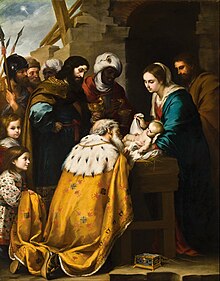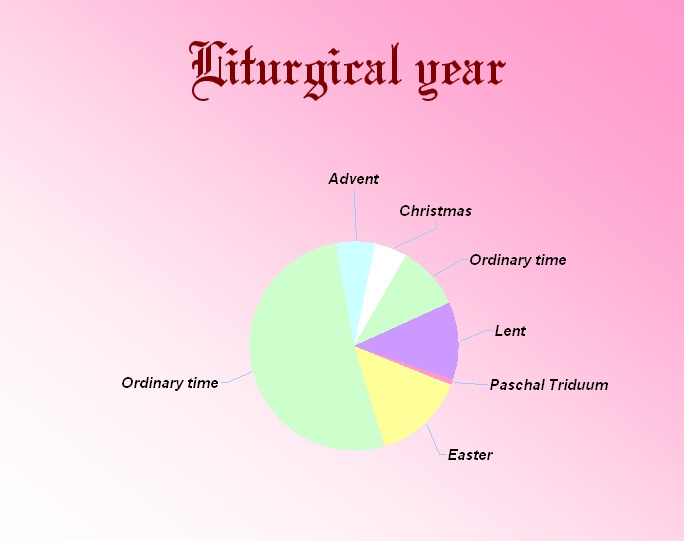
* * * *
 Each year, January 6 is the traditional day to celebrate the Feast of the Epiphany. (In this sense, an “annual religious celebration…”) See also the Satucket (or “Daily Office“) piece, on Epiphany:
Each year, January 6 is the traditional day to celebrate the Feast of the Epiphany. (In this sense, an “annual religious celebration…”) See also the Satucket (or “Daily Office“) piece, on Epiphany:
“Epiphany” is a word of Greek origin, related to such English words as “theophany,” “phenotype,” and “phenomenon.” It means an appearance, a displaying, a showing forth, a making clear or public or obvious. On this day, Christians have traditionally celebrated the making known of Jesus Christ to the world.
In other words, January 6 is celebrated as the day the world got “first introduced to Jesus,” in large part by the visit from the “Three Wise Men from the East.” That is, this Feast Day includes – but is not limited to – a celebration of “the visit of the Magi to the Christ child,” as shown in the painting above left. (The “We Three Kings of Orient are,” from the Christmas carol.)
But January 6 also marks the start of the Season of Epiphany. That church season runs from January 6 to – and through – the Last Sunday after the Epiphany. This year, 2017, that date is February 26. The following Tuesday, February 28, we celebrate Mardi Gras. The day after that – March 1 – is Ash Wednesday, which marks the beginning of the 2017 Season of Lent.
Which brings up Buzz Lightyear. (His catch-phrase – “to infinity, and beyond” – is popular among people including astronauts, philosophers and mathematical theorists…) The point being that practicing Christians also work to go “to infinity – and beyond!” Or in the words of the Book of Common Prayer, to “live with confidence in newness and fullness of life,” and to await “the completion of God’s purpose for the world.”
And that’s a promise especially meaningful after that 2016 Year from Hell. But wait! There’s more! Practicing Christians can also look forward to infinity – “without any bound” – as a new existence, with “the joy of fully knowing and loving God and each other.”
And – it could be argued – it all starts with Epiphany.
 That is, the 2017 church year officially started with the first Sunday of Advent, last November 27. That was followed by Christmas and the Season of – or after – Epiphany. That in turn will be followed by Lent – preceded by Mardi Gras – and then Easter. (It’s a full, 40-day season as well and not just a single day.)
That is, the 2017 church year officially started with the first Sunday of Advent, last November 27. That was followed by Christmas and the Season of – or after – Epiphany. That in turn will be followed by Lent – preceded by Mardi Gras – and then Easter. (It’s a full, 40-day season as well and not just a single day.)
Then comes Ordinary Time – the Season after Pentecost – which takes up over half the church year. (As shown at left.)
However, you could argue – again – that it all started with the first Epiphany. (The first “making known of Jesus Christ to the world.”) That is, Jesus was born in relative obscurity, and it wasn’t until the Three “Wise Men from the East” visited that He started to become better known.
That was the point of last January’s post Epiphany, circumcision, and “3 wise guys.” It also noted that other names for January 6 include the last day of Christmas and Three Kings Day.
The word originally used for Three Kings was Magi, which gave rise to the current word “magic.”
And in its original sense – 600 years before Jesus was born – the word Magi referred to “followers of Zoroastrianism or Zoroaster.” In turn it wasn’t until well after Jesus died that a number of traditions arose about the three Wise Men. That included their names, places of origin, and how soon after “Christmas” they actually visited the Holy family.
The most common names given the three are: Melchior, from Persia; Caspar, from India; and Balthazar, from Babylon. (Which could present some logistical difficulties; for example, in their getting together to start the trip.) And as to when they actually visited Jesus:
The Bible specifies no interval between the birth and the visit [by the Magi, but] artistic depictions … encourage the popular assumption that the visit took place the same winter as the birth… [L]ater traditions varied, with the visit [said to occur] up to two winters later. This maximum interval explained Herod’s command at Matthew 2:16–18 that the Massacre of the Innocents included boys up to two years old. (E.A.)
All of which adds up to some confusion about these post-Christmas holidays…
You’ve probably heard of the 12 Days of Christmas, which end on January 6. But the evening of the 6th is also known as 12th Night, and was yet another occasion for “drunken revelry.” (From back in the days when life – especially life in winter – was “nasty, brutish and short.”) Yet another celebration – and a time for “drunken revelry” – came on Plough Monday, which is officially the Monday following January 6. In turn, back in Merry Olde England, Plough Monday marked the start of the new Agricultural Year. In other words, a new year of work.
So the point of Plough Monday – the Monday after January 6 – was to have one more big blast before getting back to work. (That is, resuming farm-work after the extended holiday season. And for more on this seeming rigamarole, see Epiphany, circumcision, and “3 wise guys.”)
So in a way, Plough Monday is like our celebrating Mardi Gras – also called Fat Tuesday – on the day before the first day of Lent. Or: “one last feast before the Lenten fast.”
Are we seeing a pattern here?
In a sense it’s like the pattern of growth and debriefing – the asking of “really aggravating questions” – that should follow such a period of personal growth.
On that note, see DORs for June 6, 2015, which took issue with “sin” as sometimes held out:
[T]he concepts of sin, repentance and confession should be viewed as “tools to help us get closer to the target.” In other words, they help us grow and develop, and are not to be used as a means of social control… Note also that the “Biblical Greek term for sin [amartia], means ‘missing the mark,’” and implies that “one’s aim is out and that one has not reached the goal, one’s fullest potential.”
And that – after all – is what the true Christian should be working for, during these upcoming, alternating seasons of celebration and reflection: To reach his or her full potential.
So the Epiphany reminds us that – in order to do His job – Jesus had to be revealed to the world as “God incarnate.” That revelation – that “revealing” – involved a substantial risk to Jesus in His earthly incarnation as God “embodied in the flesh.” In fact, that big risk led to His ultimate – and untimely – death on the Cross. That in turn should lead us to the conclusion that our job is not to withdraw from world into the safety of being a “carbon copy Christian.”
Instead our job is to grow into our fullest potential, and that means taking risks. One such risk – for example – involves reading the Bible “with an open mind,” rather than retreating into a safe “fundamental” view. For more on that see Conservative Christian – “Career buck private?”
In the meantime, celebrate the “Adoration of the Magi,” and the season of growth to follow…
* * * *

The “Adoration of the Magi,” by El Greco…
* * * *
The upper image is courtesy of Buzz Lightyear To Infinity And Beyond by eposselt on DeviantArteposselt.deviantart.com. See also Buzz Lightyear – Wikipedia, which noted:
Buzz’s classic line “To infinity… and beyond!” has seen usage not only on T-shirts, but among philosophers and mathematical theorists as well.… The 2008 quadruple platinum song “Single Ladies” by Beyoncé includes the lyric “…and delivers me to a destiny, to infinity and beyond,” a reference which was pointed out by alt-country singer Jeff Tweedy of the band Wilco during a 2010 solo performance in Chicago. Also in 2008, astronauts took an action figure of Buzz Lightyear into space on the Space Shuttle “Discovery” as part of an educational experience for students while stressing the catchphrase…
Re: The Book of Common Prayer references. See The Catechism, at pages 861-862
Re: “Year from hell.” The website 2016 has been year from hell for many – but not for comics, noted another name: “Annus horribilis.” Wikipedia noted that the opposite term – annus mirabilis, meaning “wonderful year” – has a long history of usage, but “annus horribilis” was apparently first used in 1891. At that time it was used to “describe 1870, the year in which the Roman Catholic church defined the dogma of papal infallibility.” As to its application to 2016, Googling the phrase “2016 year from hell” got me some 173,000,000 – 173 million – results.
Re: “Magi,” giving rise to the current word “magic.” See Asimov’s Guide to the Bible (Two Volumes in One), Avenel Books (1981), at page 788. See Asimov’s full “Curriculum vitae” in last October’s On St. Ignatius – and “Persecution Porn.”
The lower image is courtesy of Epiphany (holiday) – Wikipedia. The full caption: “‘Adoration of the Magi‘ by El Greco, 1568, Museo Soumaya, Mexico City.”